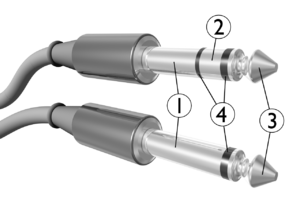|
index
555 touch sensor
air mike
amplify your toy
box your toy
circuit sniffing
clock tickling
contact mike
electret mike
hack the clock
laying and hacking
laying of hands
light theremin
make a cable
mapping
pickup
piezo driver
resistors
soldering
sudomini
synthesis
tape head
|
Make a useful cable.
One of the first things you should learn is how to make and fix your own cables. Apart from saving you some money, this will give you confidence and teach you how to solder. In this task I'm going to suggest that you make a cable that you can use to output from your laptop or your circuit bending creation to most mixers: a mini-jack to a quarter inch jack lead. However, feel free to suggest other leads if you like - maybe you already have enough mini-jack to jack leads.
For the cable mentioned above you will need:
- A couple of metres of two/three core screened audio cable.
- Mono (TS) or stereo (TRS) minijack plug.
- Mono or stereo quarter-inch jack plug.
- Whether you use TS or TRS plugs is up to you.
Obviously if you choose to make a different lead, you'll need the relevant components.

1. Sleeve: usually ground
2. Ring: Right-hand channel for stereo signals, negative polarity for balanced mono signals, power supply for power-requiring mono signal sources
3. Tip: Left-hand channel for stereo signals, positive polarity for balanced mono signals, signal line for unbalanced mono signals
4. Insulating rings
More info here: http://en.wikipedia.org/wiki/TRS_connector
 The Task The Task
- Make a cable.
- Ideally get some practice by making two!
- Document the process with plans, photos and, yes, videos of it and of it working, and include this documentation in your logbooks.
- Media files
You must submit media files, such as video, audio or image files, but please ensure that video files are compressed to a reasonable degree. You should never submit dv files, but compress these to mp4. You should submit no file that is greater in size than 25MB/minute.
- Added value
By completing the details of the task you will achieve at least a pass mark. By imaginatively and creatively considering how you might implement the task originally you can add value to your submission, and this added value may increase your mark significantly. Even when making videos of short demonstration tasks try to consider musical and performance criteria.
- Suggested questions to consider answering in your logbook
- Why are hot solders better than cold solders, and how do you ensure that you create the former?
- In some cables you find a copper mesh surrounding the inner wires. Why is this mesh there?
- Include all these components in one section of your logbook. Include images within the logbook, and any audio or video recordings alongside.
- Submit your logbook to the i-Centre by 2pm on Tuesday 8th May 2018
|
|
